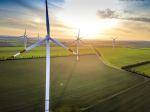In the age of edge computing and green energy, have you ever wondered what it’s like to be behind the scenes of a futuristic project? In this video, Bucknell University students Hank Bethel and Henry Qiu describe their amazing demo that uses edge computing to keep wind turbines safe and operational. With the power of VMware Edge Compute Stack at their disposal, and in partnership with VMware and Kyndryl, these innovative minds were able to bring this idea to life. Watch the video as they share some insights on how they got things off the ground and reveal the technical details behind their project.
(If you don’t see the video here, click for the YouTube link.)
Presented at Hannover Messe 2023, the demo shows a single edge node equipped with VMware Edge Compute Stack at a wind turbine. A thermal camera transmits images of the turbine to the edge node, where a machine learning algorithm examines the images to detect any irregularities in the turbine’s functioning. VMware SD-WAN™ ensures a secure uplink for transmitting the analyzed results to a central operations hub. By running a machine learning algorithm locally on the Edge Compute Stack, bandwidth usage is significantly reduced, enabling intelligent real-time decision-making to prevent turbine failures. Furthermore, the software can issue commands to local PLCs, automatically shutting down the wind turbine without the need for human intervention.
Check out the blog post VMware, Kyndryl, Bucknell University Show Smart Wind Turbine Predictive Maintenance at Hannover Messe 2023 to learn more about the demo.
Bucknell student Hank Bethel is the project manager for the Kyndryl senior design team. In the video, he presents the team’s Energy site Edge Computing system equipped with a machine learning model running on VMware Edge Compute Stack. The unique design offers a remarkable range of features and capabilities. The model’s core function is local information processing at the edge. The team demonstrated this with an RTSP stream, analyzed it using machine learning algorithms, and controlled the turbine’s operations—all without the need for stable internet connection.
The demo shows an ideal solution for remote locations in areas with limited connectivity. One of the key strengths of the system lies in its flexibility because of the use of edge computing and intelligence in software. This flexibility allows the team to easily extend capabilities such as updating the AI model or adding new detection capabilities to work with new sensors. As a result, the wind turbine model can be easily adapted and upgraded to meet evolving demands and requirements.
Henry Qiu, one of the design engineers on the project, designed the physical model. Qiu notes that the advanced wind turbine model incorporates machine learning to analyze data, allowing it to detect objects within the camera’s field of view and monitor motor vibrations. It uses an industry-ready thermal camera not only to monitor temperature changes and key components, but also to identify specific issues by analyzing heat patterns. These features could help optimize turbine performance, ensure safety and minimize potential issues. This technology offers incredible potential for the renewable energy industry.
Learn more
- Visit the VMware Edge Compute Stack web page
- Go to the VMware SD-WAN and SASE web page
- Learn more about the VMware-Kyndryl partnership at the Kyndryl website







